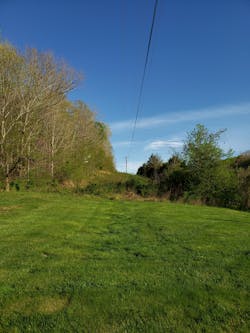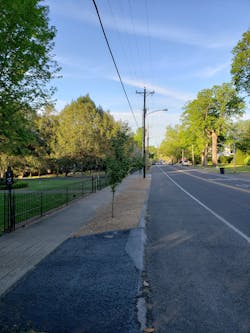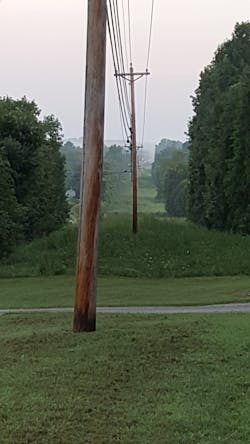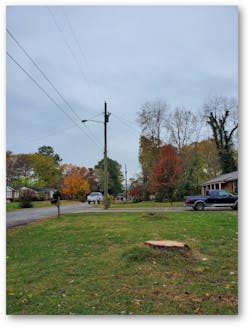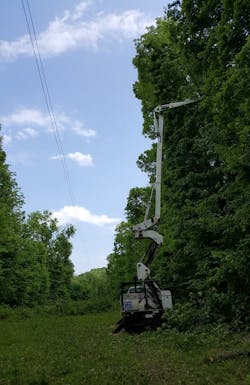To maintain a 2200-square-mile service territory with 14,000 miles of line, vegetation management takes center stage at Middle Tennessee Electric. Founded in 1936, the Murfreesboro, Tennessee, utility has grown to serve more than 600,000 Tennesseeans and is now one of the largest electrical cooperatives in the nation.
Its vegetation management (VM) services and programs not only maintain safe and secure rights of way (ROWs) but also keep members informed about the importance of VM. MTE’s management and the board of directors understand the relationship between a good ROW maintenance program and reliability, which has been invaluable to the success of the MTE VM division.
Over the past year, its VM division — whose overall program has been accredited by the Arbor Day Foundation’s Tree Line USA Program — has been hard at work navigating a variety of changes designed to not only enhance operations and reduce costs but also to strengthen service to its members throughout its service territory.
Joining Forces to Streamline Operations and Service
In mid-2020, MTE made the strategic decision to pursue and complete a merger with Murfreesboro Electric Department (MED) — a city-owned electric provider for the City of Murfreesboro in the center of its service territory.
Because of their proximity to one another, both MED and MTE recognized a duplication (and the continued potential for additional duplication) with substations, feeder lines and other aspects of their services. For example, MED provided service up to the Murfreesboro city limit while MTE served members in Rutherford County just beyond it. As it stood, both areas would require separate substations feeding those loads.
Both utilities recognized that as a unified organization, they would be able to continue serving membership while reducing costs associated with these duplications. Additionally, combining their teams resulted in a larger and stronger workforce, creating more opportunities to proactively serve and support their membership.
The merger was completed in July 2020. Because of the nature of their work, most MTE and MED employees were already familiar with one another and had a solid working relationship, which made the transition seamless. On the VM side, both utilities’ ROW departments began working to consolidate efforts and accelerate progress on ensuring reliable power distribution for members.
In addition to strengthening its team, MTE continues to offer a 24/7 monitoring service where members can call in to report and get updates on power outages. MED members who have become part of the MTE family can now take advantage of this as well as participate in its annual meeting where they have a direct say in governance.
Extending Pruning Cycles
Today, the unified team is making rapid progress on a new pruning cycle. Currently, MTE is on a six-year cycle with a two-year mid-cycle pruning. With the help of its utility vegetation management (UVM) partner, ACRT, the utility is working to extend this cycle to a three-year mid-cycle prune. The aim is two-fold: to reduce costs associated with VM along the ROW and lines and to reduce the frequency in which MTE is conducting work on members’ properties.
On the current two-year mid-cycle prune, members’ perception is that any required pruning work was only just recently completed — and now MTE is back for more. Increasing the amount of time between mid-cycle pruning will help to reduce the frequency of possible property damage, customer frustrations and other related challenges.
To achieve this goal, MTE has leaned on tree-growth regulators (TGR) as part of its ROW strategy. This effort has allowed them to keep the trees in a holding pattern following a pruning cycle. The year after conducting pruning, MTE applies TGR, which remains in the trees for three to five years. To ensure this part of the strategy is being conducted properly, MTE leans on its UVM partner to conduct quality control checks on pruning and TGR application.
On the cost end, this shift from two-year mid-cycle pruning to three-year mid-cycle pruning is expected to reduce associated costs significantly. It costs about half as much to treat a tree with TGR as it does to perform a mid-cycle pruning. Each region throughout the MTE service territory is about 300 miles. Currently, the ROW maintenance costs for MTE are among the lowest across the Tennessee Valley Authority (TVA) area due to reclamation efforts that have occurred over several years. In the two-year program, MTE had been pruning two regions per county every two years. In the three-year program, MTE is now able to do one region per county. This year marks the last year of its transition from two-year to three-year mid-cycle pruning, with complete integration expected by the start of 2022.
The MTE VM team has also grown over the past few years thanks to the expertise and participation of its UVM partner. ACRT consulting utility foresters have transitioned to the MTE team as VM specialists and can help achieve short- and long-term goals. A VM support specialist also handles all the administrative functions, such as timesheets, invoices and other related work. With more than 60 years of combined experience, these individuals understand the challenges that cooperatives like MTE face daily with regards to VM, member communications, industry regulations and other needs. They continue to play a valuable role in MTE’s daily VM operations.
Investing in an Herbicide Program
Alongside efforts to extend its mid-year pruning cycles, MTE has also extended its herbicide spray program. The herbicide is applied every three years to the same areas throughout each region in the counties it serves and only on woody species in the unmaintained ROWs. In total, MTE applies the herbicide, as needed, to roughly 2,000 miles of primary line annually. If any saplings meeting the necessary criteria are found to be growing in these areas, low-volume backpack sprayers apply the herbicide. To date, MTE has achieved a “maintenance mode” with ROWs, meaning that little product is required each time.
MTE continues to communicate the importance of this low-impact program to members to ensure they’re educated on the details by directing them to in-depth FAQ pages on its website — for both the herbicide program and TGR initiative. To date, MTE has received very little member pushback on this program, allowing them to ensure the ROW is protected and potentially invasive or disruptive vegetation is addressed. Next year, its UVM partner will be auditing the results of the herbicide program to ensure all application areas are properly covered and any missed spots are addressed right away.
Combating the Emerald Ash Borer (EAB)
The Emerald Ash Borer (EAB) has harmful effects on ash trees, and dead or dying trees can cause damage to power lines or property. As with many other central and eastern U.S. states, EAB is active in MTE’s service territory and has been since 2010. To protect its lines and ensure the utility is providing the best possible service to members, the VM team has conducted member education and tree removals wherever EAB is present beyond its 40-ft ROW in conjunction with its UVM partner.
Thanks to its education efforts, MTE has received a high level of permission from members. This success has allowed them to stay ahead of the curve on EAB and prevent the insect from causing damage or outages along the ROW. Its UVM partner has been instrumental in this effort, as they’ve been assisting MTE with door-to-door communication efforts, leaving informative door hangers, conducting calls to members, sending letters, identifying and tracking down property owners, and starting conversations about why EAB must be addressed wherever it is found.
As a result of this work throughout its service territory, MTE has been able to reduce VM program costs, improve power distribution reliability and service to its members, reduce the presence of harmful and invasive vegetation and insects and ultimately enjoy a more efficient program.
Talley Floyd ([email protected]) has been the vegetation program manager at Middle Tennessee Electric since 2016. Floyd transitioned to his current role after serving 29 years on the MTE engineering team. Throughout his career, Floyd has played an integral part in providing reliable power distribution to the hundreds of thousands of members that rely on the utility every day. He is an International Society of Arboriculture (ISA) certified arborist and utility specialist. Additionally, he holds a Bachelor of Science degree in agribusiness from Middle Tennessee State University.
About the Author
Talley Floyd
Talley Floyd ([email protected]) has been the vegetation program manager at Middle Tennessee Electric since 2016. Floyd transitioned to his current role after serving 29 years on the MTE engineering team. Throughout his career, Floyd has played an integral part in providing reliable power distribution to the hundreds of thousands of members that rely on the utility every day. He is an International Society of Arboriculture (ISA) certified arborist and utility specialist. Additionally, he holds a Bachelor of Science degree in agribusiness from Middle Tennessee State University.


